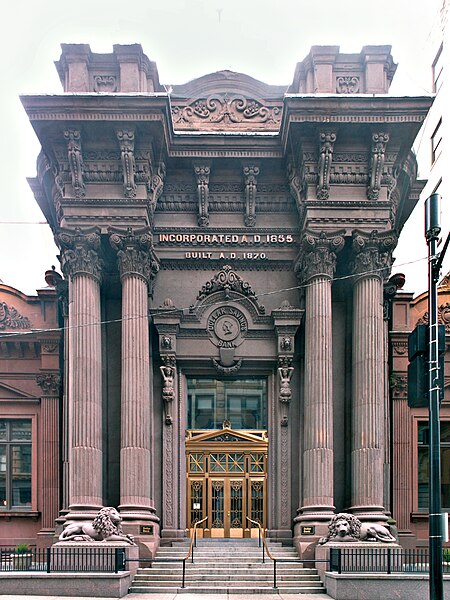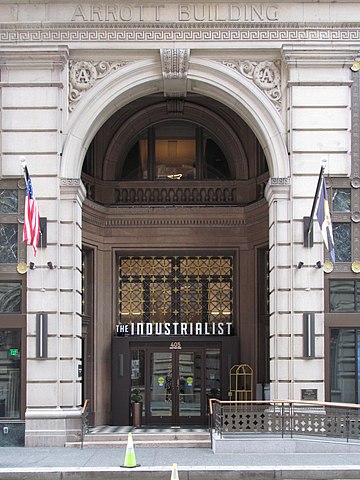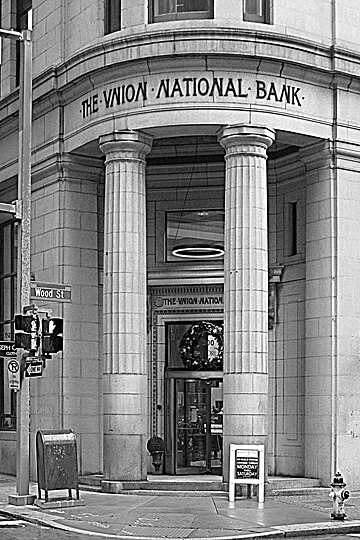
Left to right: Arrott Building, Investment Building, Benedum-Trees Building.

This little bank on Fourth Avenue was originally designed by Alden and Harlow. The central section has been ruthlessly mutilated, with the elegant arch replaced by a cartoon suggestion of an arch. For reasons unknown, much of the rest of the building was left untouched (although it is pretty clearly missing its top), and the details there are enough to make it worth our while to stop and admire them.


Of course there are lions. How could there not be lions?


The adjective “tasteful” does not naturally attach itself to this structure. It has the look of a building specified by a banker who hired an expensive architect and was determined to wring every cent of his money’s worth out of the details. It is magnificent in a slightly horrifying way: this is the kind of monstrosity that was in the minds of the modernists when they condemned all things Victorian. Old Pa Pitt would not change a single swirl or swag or grotesque half-vegetable naked lady.
The architect in question was the firm of Isaac H. Hobbs & Sons from Philadelphia. Isaac H. Hobbs was a kind of celebrity architect. He was familiar to the thousands of ladies across our fair land who read Godey’s Lady’s Book, the premier fashion magazine of the middle 1800s: every month, Hobbs contributed a design for an elaborately Victorian residence for the lady readers to drool over. It was something like having a regular segment on a popular daytime talk show today. According to the Pittsburgh History and Landmarks Foundation’s Fourth Avenue walking tour (PDF), Hobbs designed a number of houses around Pittsburgh, but Father Pitt does not know any of them; he wonders whether they were original designs, or whether they were adaptations of the many designs published in Godey’s.

It appears that the crust of 150-year-old ornamentation requires some stabilization: netting is stretched over the top half of the building at the moment.


After much expensive restoration and renovation, the Arrott Building (designed by Frederick Osterling) has reopened as a hotel called “The Industrialist.” The exquisite lobby has been carefully preserved. The picture above is huge, stitched together from several photographs to make what may be the only complete head-on picture of the Wood Street façade of the building on the internet.


This is very definitely a corner building, and architects MacClure and Spahr made the corner the most identifiable thing about it. That curved corner runs all the way up to the top, and the main entrance is right on the corner of Fourth and Wood.
Notice the capitals on those prominent columns. How do you adapt square Doric capitals to a fairly tight curve? Making them octagonal is a solution that might have given Vitruvius a stroke, but works very well in this context.
The building is now luxury apartments under the name “The Carlyle.”

The ornate top of the Benedum-Trees Building on Fourth Avenue, reflected in the glass front of the Patterson Building on Third Avenue. This is a two-color rendition, like an old postcard or a two-strip Technicolor movie. We are going to see quite a lot of Fourth Avenue and nearby in the next few days.

The Bank Tower, as it is now called, has a brand-new painted sign on the back side. The building, finished in 1902, was designed by the prolific firm of Alden & Harlow, Andrew Carnegie’s favorite architects.
[A correction: An earlier version of this article identified Alden & Harlow as a Boston firm, but they had moved to Pittsburgh by this time, leaving their former partner Longfellow behind.]